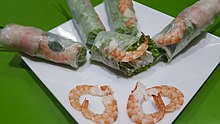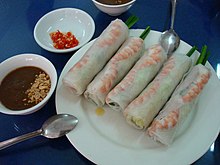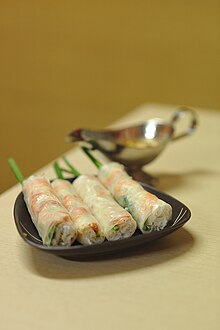Gỏi cuốn
 Gỏi cuốn wrapped in Vietnamese bánh tráng | |
| Alternative names | Nem cuốn, fresh spring roll, summer roll, salad roll, cold roll, rice paper roll |
|---|---|
| Course | Hors d'oeuvre |
| Place of origin | Vietnam |
| Region or state | Southeast Asia |
| Serving temperature | Room temperature |
| Main ingredients | Pork, prawns, vegetables, bún, and bánh tráng |
Gỏi cuốn, Vietnamese spring roll, summer roll, fresh spring roll, spring roll, or rice paper roll, is a Vietnamese dish traditionally consisting of pork, prawn, vegetables, bún (rice vermicelli), and other ingredients wrapped in Vietnamese bánh tráng (commonly known as rice paper or cold roll). Unlike other spring roll dishes which are believed to be originated from China, Vietnamese gỏi cuốn is the country's creation using rice paper ]
Gỏi cuốn are served fresh while others are served fried, like the Vietnamese chả giò. They are served at room temperature (or cooled) and are not deep-fried or cooked on the outside. These rolls are considered to be a very popular appetizer with customers in Vietnamese restaurants.
Preparation
The bánh tráng (rice paper) is dipped in water, then laid flat on a plate with the desired amount of ingredients placed on top. The fresh gỏi cuốn is then rolled up and ready to be eaten. Gỏi cuốn can be served with tương xào (also known as hoisin sauce), which consists of ground tương (tương đen or tương xay) and mixed coconut water (or broth), before being stir-fried with garlic and some sugar and then sprinkled with chili powder and ground peanuts. Alternatively, gỏi cuốn can be served with peanut sauce or other Vietnamese dipping sauces, such as nước chấm, a condiment based on fish sauce.[2]
In Vietnam and in various parts of Southeast Asia, Vietnamese can be seen hand-making bánh tráng (rice paper) and placing them on the rectangular bamboo trays around their houses. Traditionally, gỏi cuốn are eaten with a large group of people at a home setting.
Regional[edit]
In southern Vietnam, these rolls are called gỏi cuốn, meaning salad rolls, while in northern Vietnam, these rolls are called nem cuốn, meaning nem rolls. In central Vietnam, they are simply called "rice paper" rolls. In the West, these rolls are called by several different English names, including "salad roll", "spring roll" and "summer roll." Sometimes the word "Vietnamese" is added at the beginning of these words; for example, in Hong Kong, they are called "Vietnamese rolls", and in Australia and the United States they may be called "Vietnamese spring rolls" (although specifically in Australia they may sometimes be referred to as "cold rolls"). Some Asian restaurants in the United States also refer to them as "crystal rolls", "soft rolls" or "salad rolls". The name "summer roll" was popularized by some Vietnamese American restaurants for easier marketing and as a seasonal play on the term "spring roll". But many Vietnamese American restaurants still use "spring roll" as the English translation.
I have extracted the vital sections from Wikipedia.
To sum up, the essential differences are
1 That other spring rolls are fried. The Vietnamese ones contain what I call glass noodles. They are see-through.
2 The Vietnamese rolls contain noodles which are not made from flour but from rice.
3 The spring roles are eaten cold instead of hot.
4 The outsides may be green, which at first strikes you as odd, but when you bite into them and find lots of salad they soon seem to represent healthy greenery and are refreshing. I think of them as salad rolls.
Useful Websites













No comments:
Post a Comment